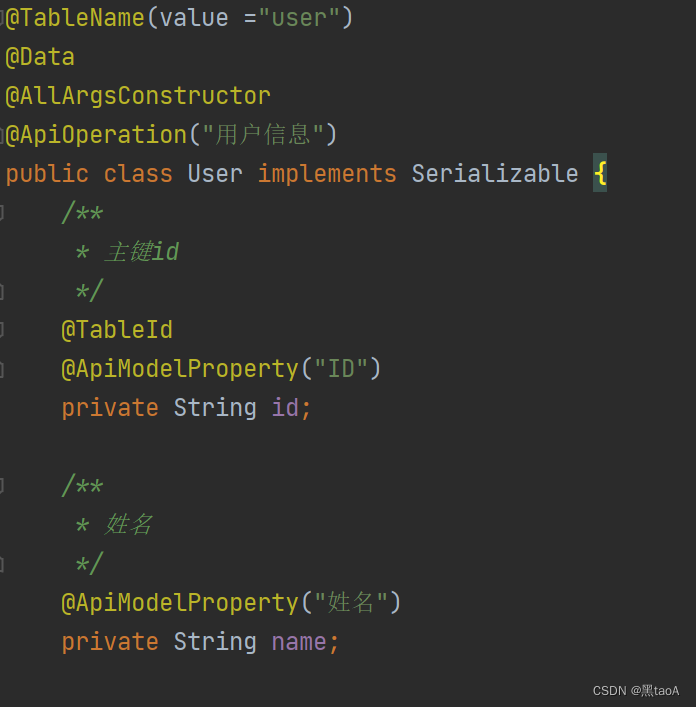1. Introduce related dependencies
<!--swagger-->
<dependency>
<groupId>io.springfox</groupId>
<artifactId>springfox-swagger2</artifactId>
<version>3.0.0</version>
</dependency>
<dependency>
<groupId>io.springfox</groupId>
<artifactId>springfox-swagger-ui</artifactId>
<version>3.0.0</version>
</dependency>
<dependency>
<groupId>io.swagger</groupId>
<artifactId>swagger-annotations</artifactId>
<version>1.5.22</version>
</dependency>
<dependency>
<groupId>com.github.xiaoymin</groupId>
<artifactId>swagger-bootstrap-ui</artifactId>
<version>1.8.7</version>
</dependency>
PS: When introducing dependencies, pay attention to the swagger version corresponding to the Springboot version, otherwise a null pointer exception will occur!
Related versions: (I use springboot: 2.6.6+swagger3.0.0)
Version one:
| Spring Boot version | Swagger version |
|---|---|
| 2.5.6 | 2.9.2 |
Version two:
| Spring Boot version | Swagger version |
|---|---|
| 2.6.5 | 3.0.0 |
2. Add configuration information
Add configuration:
spring:
mvc:
pathmatch:
matching-strategy: ant_path_matcher
Create a configuration class:
@Configuration
@EnableSwagger2
public class Swagger2Config {
@Bean
public Docket webApiConfig(){
return new Docket(DocumentationType.SWAGGER_2)
.groupName("webApi")
.apiInfo(webApiInfo())
.select()
//过滤掉admin路径下的所有页面
.paths(Predicates.not(PathSelectors.regex("/admin/.*")))
//过滤掉所有error或error.*页面
.paths(Predicates.not(PathSelectors.regex("/error.*")))
.build();
}
@Bean
public Docket adminApiConfig(){
return new Docket(DocumentationType.SWAGGER_2)
.groupName("adminApi")
.apiInfo(adminApiInfo())
.select()
//只显示admin路径下的页面
.paths(Predicates.and(PathSelectors.regex("/admin/.*")))
.build();
}
private ApiInfo webApiInfo(){
return new ApiInfoBuilder()
.title("网站-课程中心API文档")
.description("本文档描述了课程中心微服务接口定义")
.version("1.0")
.contact(new Contact("sun", "http://atguigu.com", "[email protected]"))
.build();
}
private ApiInfo adminApiInfo(){
return new ApiInfoBuilder()
.title("后台管理系统-课程中心API文档")
.description("本文档描述了后台管理系统课程中心微服务接口定义")
.version("1.0")
.contact(new Contact("sun", "http://atguigu.com", "[email protected]"))
.build();
}
}
3. Swagger annotation description
@Api(tags="")
is used on the requested class to indicate the description of the class.
tags "describe the function of the class, and can be seen on the UI interface"
@ApiOperation(value="")
is used on the requested method to explain the purpose and function of the method
value="Describe the purpose and function of the method"
@ApiImplicitParams
is used on the requested method to indicate a set of parameter descriptions
@ApiImplicitParam
@ApiImplicitParam: specify all aspects of a request parameter
value: the Chinese character description and explanation of the parameter
required: whether the parameter must be passed
paramType: where the parameter is placed
header –> request header acquisition: @·RequestHeader
query –> request parameter Acquisition: @RequestParam
path (for restful interface) –> Acquisition of request path variables:
@PathVariable
body (not commonly used)
form (not commonly used)
dataType: parameter type, default String, other values dataType="Integer"
defaultValue: default value of the parameter
@ApiResponses
is used on the request method to represent a set of responses
@ApiResponse
is used in @ApiResponses, generally used to express a wrong response information
code: number, such as 400
message: information, such as "request parameters are not filled in"
response: the class that throws an exception
@ApiModel
has two main uses:
It is used on the response class to represent information that returns response data.
Input entity: When using scenarios like @RequestBody, the request parameters cannot be described using the @ApiImplicitParam annotation
@ApiModelProperty
is used on properties to describe the properties of the response class
4. Page example



